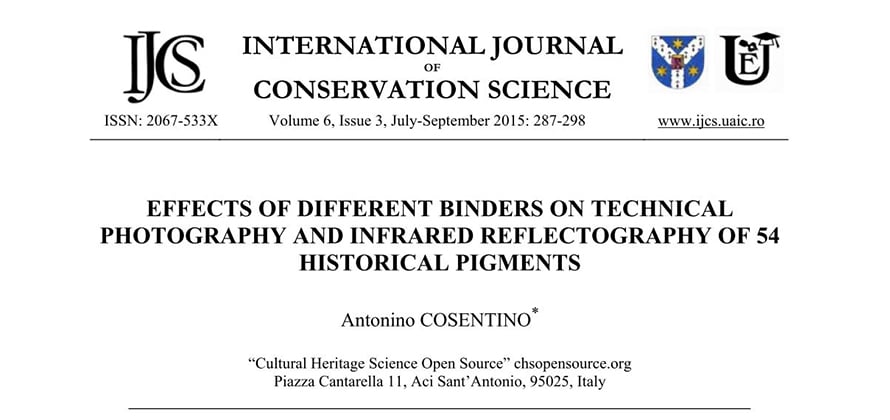
Just published: A. Cosentino “Effects of Different Binders on Technical Photography and Infrared Reflectography of 54 Historical Pigments” International Journal of Conservation Science, 6 (3), 287-298, 2015.
DOWNLOAD
Effects of Different Binders on Technical Photography and Infrared Reflectography of 54 Historical Pigments (9377 downloads )Technical Photography (TP) is the collection of broadband spectral images in the range 360 – 1100 nm collected with a modified digital camera: visible (VIS), ultraviolet fluorescence (UVF), reflected ultraviolet (UVR), infrared (IR), infrared fluorescence (IRF) and infrared false color (IRFC). An InGaAs camera is sensitive to the 900-1700 nm range and provides infrared reflectography (IRR) images. It was previously shown that all these techniques used together allow a tentative identification of pigments laid with gum arabic. While the identification must be confirmed with analytical instruments, this flowchart method allows a fast and low-cost preliminary examination of polychrome works of art. This paper discusses the effects that other binders (egg tempera, linseed oil and fresco) can have on technical photos and on infrared reflectography images of 54 historical pigments. It is shown that only the UVF photos are considerably affected by these binders. The strong fluorescence emission of egg tempera and linseed oil dominate the UVF photos while the binders do not consistently affect the other technical photos, IR, IRF, IRFC and IRR. This study confirmed the validity of this comparative method for the tentative identification of pigments laid with the most common binders used on works of art.







More brilliant and practical work, clearly presented!
How well do you think the Nikon Nikkor 50mm f/1.8D AF lens works for reflected UV, especially 254 nm UV, and for focus shift at different wavelengths? It’s not known as a UV-transmissive or apochromatic lens. Does it require high ISO settings and long exposures to capture reflected UV? I realize these questions aren’t the primary concern of this paper.
Images must be properly registered for false-color IR (IRFC) and false-color UV (UVFC), (although you didn’t discuss UVFC in this paper). With color patches, you can generate IRFC and UVFC images without much worry about accurate registration, but for details on real paintings, accurate image registration of the stacks would become a concern. For examination of real paintings, do you find the same Nikkor 50mm lens works well, or do you use more specialized lenses like the Coastal Optics Apo Macro 60 mm or Nikon UV-Nikkor 105 mm?
Thanks, Antonino!
Best,
Taylor
Hi Taylor, thanks for your appreciation of this paper. It was something I wanted to write down some notes since many of the professionals working with Technical Photography were wondering what the effect of the different binders could be. Regarding your questions: A) we cannot do UVR at 254 nm. The camera is not sensitive to this region, as far as I know, but I would be surprised if it was. Furthermore, there isn’t much information in the UV further than 360 nm, as we can see in reflectance spectra. So, I would not bather that much on imaging in the 254 nm region.
B) The 50mm lens works fine and an Coastal Optics is way to expensive. 🙂
Cheers!
A
Hi Antonino,
That’s good to know that you can use more a affordable Nikon lens to do this work without excessive exposure times and ISO settings for UVR. I know the Coastal Optics lens and UV-Nikkor 105mm are way too expensive for most budgets (in the U.S.A. and Canada, one can rent the Coastal Optics lens from Lens Rentals, but not in Europe or elsewhere, unfortunately). I know other conservators who will be very happy to know this, too.
I had read that the type of glass and the coatings in most consumer lenses (even very good ones) block most of the UV, and since CCD or CMOS sensors have lower sensitivity from 350-400 nm, this could require long exposures and/or high ISOs, resulting in noisy images. It’s very welcome news that this isn’t always the case. It’s also good to know that focus shift and image registration aren’t much of a problem for IRFC with your 50mm f/1.8 lens.
I’ve purchased a used Noflexar 35 mm macro lens with good UV transmissivity (only certain versions do), and after it arrives, I’ll do some comparisons with my regular lenses for UVR and let you know how the results compare.
Thanks again,
Taylor
Hi Taylor, thanks, your tests on this Noflexar 35 mm macro lens would be much appreciated!